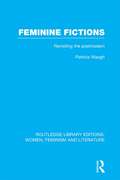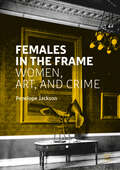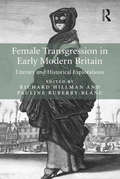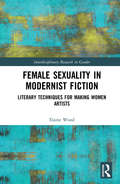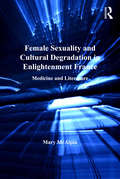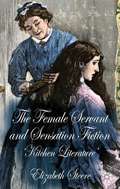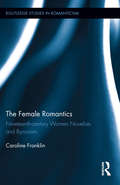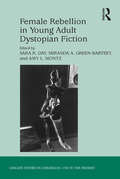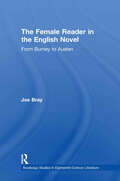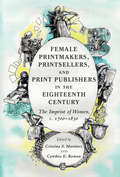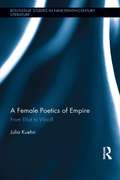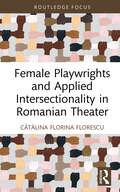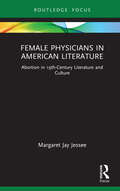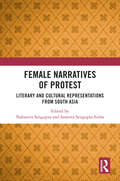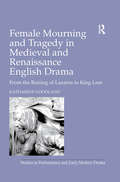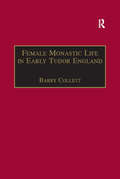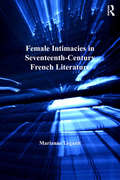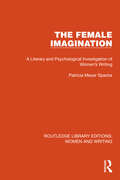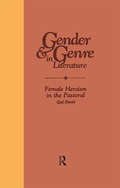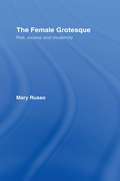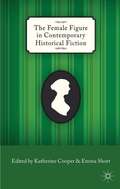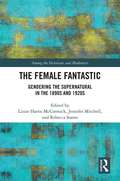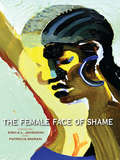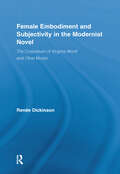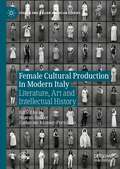- Table View
- List View
Feminine Fictions: Revisiting the Postmodern (Routledge Library Editions: Women, Feminism and Literature)
by Patricia Waugh‘Postmodernism’ and ‘feminism’ have become familiar terms since the 1960s, developing alongside one another and clearly sharing many strong points of contact. Why then have the critical debates arising out of these movements had so little to say about each other? Patricia Waugh addresses the relationship between feminist and postmodernist writing and theory through the insights of psychoanalysis and in the context of the development of modern fiction in Britain and America. She attempts to uncover the reasons why women writers have been excluded from the considerations of postmodern art. Her route takes her through the theorization of self offered by Freud and Lacan and on to the concept of subjectivity articulated by Kleinian and later object-relations psychoanalysts. She argues that much women’s writing has been inappropriately placed and interpreted within a predominantly formalist-orientated aesthetic and a post-Freudian/liberal, individualist conceptualization of subjectivity and artistic expression. This tendency has been intensified in discussions of postmodernism, and a new feminist aesthetic is thus badly needed. In the second part of the book Patricia Waugh analyses the work of six ‘traditional’ and six ‘experimental’ writers, challenging the restrictive definitions of ‘realist’, ‘modernist’, ‘postmodernist’ in the light of the theoretical position developed in part one. Authors covered include: Woolf (viewed as a postmodernist ‘precursor’ rather than a ‘high’ modernist), Drabble, Tyler, Plath, Brookner, Paley, Lessing, Weldon, Atwood, Walker, Spark, Russ, and Piercy.
Females in the Frame: Women, Art, and Crime
by Penelope JacksonThis book explores the untold history of women, art, and crime. It has long been widely accepted that women have not played an active role in the art crime world, or if they have, it has been the part of the victim or peacemaker. Women, Art, and Crime overturns this understanding, as it investigates the female criminals who have destroyed, vandalised, stolen, and forged art, as well as those who have conned clients and committed white-collar crimes in their professional occupations in museums, libraries, and galleries. Whether prompted by a desire for revenge, for money, the instinct to protect a loved one, or simply as an act of quality control, this book delves into the various motivations and circumstances of women art criminals from a wide range of countries, including the UK, the USA, New Zealand, Romania, Germany, and France. Through a consideration of how we have come to perceive art crime and the gendered language associated with its documentation, this pioneering study questions why women have been left out of the discourse to date and how, by looking specifically at women, we can gain a more complete picture of art crime history.
Female Transgression in Early Modern Britain: Literary and Historical Explorations
by Richard Hillman Pauline Ruberry-BlancPresenting a broad spectrum of reflections on the subject of female transgression in early modern Britain, this volume proposes a richly productive dialogue between literary and historical approaches to the topic. The essays presented here cover a range of ’transgressive’ women: daughters, witches, prostitutes, thieves; mothers/wives/murderers; violence in NW England; violence in Scotland; single mothers; women as (sexual) partners in crime. Contributions illustrate the dynamic relation between fiction and fact that informs literary and socio-historical analysis alike, exploring female transgression as a process, not of crossing fixed boundaries, but of negotiating the epistemological space between representation and documentation.
Female Sexuality in Modernist Fiction: Literary Techniques for Making Women Artists (Interdisciplinary Research in Gender)
by Elaine WoodFemale Sexuality in Modernist Fiction: Literary Techniques for Making Women Artists provides a chronological investigation of the innovative writing styles of canonical modernist writers to reveal a shift in gendered representations of sexual subjectivity. Positioned at the nexus of studies on the body and sexuality in modernist literature, this book addresses the complex ways that constructions of female sexuality are understood culturally, politically, and epistemologically. Using close reading strategies to identify how modernist authors challenge representations of female positionality as passive, case studies consider how canonical modernist authors – Virginia Woolf, W.B. Yeats, James Joyce, and Samuel Beckett – found new ways to represent women as embodied, sexual, desired, and desiring subjects through prose, poetry, and drama. This book addresses Woolf’s Orlando: A Biography (1928), Yeats’ The Winding Stair and Other Poems (1933), Joyce’s Finnegans Wake (1939), Beckett’s Not I (1972), and other dramatic works. By rendering sexuality more obviously as a component of female character, these works of modernist literature shape our understanding of the artistic body as a structure for thinking about "woman" as a linguistic construct and material reality. This study is will be of great interest to scholars in English literature, women and gender studies, and sexuality studies.
Female Sexuality and Cultural Degradation in Enlightenment France: Medicine and Literature
by Mary McAlpinIn her study of eighteenth-century literature and medical treatises, Mary McAlpin takes up the widespread belief among cultural philosophers of the French Enlightenment that society was gravely endangered by the effects of hyper-civilization. McAlpin's study explores a strong thread in this rhetoric of decline: the belief that premature puberty in young urban girls, supposedly brought on by their exposure to lascivious images, titillating novels, and lewd conversations, was the source of an increasing moral and physical degeneration. In how-to hygiene books intended for parents, the medical community declared that the only cure for this obviously involuntary departure from the "natural" path of sexual development was the increased surveillance of young girls. As these treatises by vitalist and vitalist-inspired physiologists became increasingly common in the 1760s, McAlpin shows, so, too, did the presence of young, vulnerable, and virginal heroines in the era's novels. Analyzing novels by, among others, Jean-Jacques Rousseau, Denis Diderot, and Choderlos de Laclos, she offers physiologically based readings of many of the period's most famous heroines within the context of an eighteenth-century discourse on women and heterosexual desire that broke with earlier periods in recasting female and male desire as qualitatively distinct. Her study persuasively argues that the Western view of women's sexuality as a mysterious, nebulous force-Freud's "dark continent"-has its secular origins in the mid-eighteenth century.
The Female Servant And Sensation Fiction
by Elizabeth SteereThe Female Servant and Sensation Fiction: 'Kitchen Literature' explores why Victorian sensation fiction was derided as literature fit only for maids and cooks and how the depictions of fictional female domestics, from Jane Eyre to Neo-Victorian novels, reflect contemporary social concerns about the blurring of the boundaries of class and gender.
The Female Romantics: Nineteenth-century Women Novelists and Byronism (Routledge Studies in Romanticism)
by Caroline FranklinAwarded the Elma Dangerfield Prize by the International Byron Society in 2013 The nineteenth century is sometimes seen as a lacuna between two literary periods. In terms of women’s writing, however, the era between the death of Mary Wollstonecraft and the 1860s feminist movement produced a coherent body of major works, impelled by an ongoing dialogue between Enlightenment ‘feminism’ and late Romanticism. This study focuses on the dynamic interaction between Lord Byron and Madame de Staël, Lady Morgan, Mary Shelley and Jane Austen, challenging previous critics’ segregation of the male Romantic writers from their female peers. The Romantic movement in general unleashed the creative ambitions of nineteenth-century female novelists, and the public voice of Byron in particular engaged them in transnational issues of political, national and sexual freedom. Byronism had itself been shaped by the poet’s incursion onto a literary scene where women readers were dominant and formidable intellectuals such as Madame de Staël were lionized. Byron engaged in rivalrous dialogue with the novels of his female friends and contemporaries, such as Caroline Lamb, Mary Shelley and Jane Austen, whose critiques of Romantic egotism helped prompt his own self-parody in Don Juan. Later Victorian novelists, such as George Sand, the Brontë sisters and Harriet Beecher Stowe, wove their rejection of their childhood attraction to Byronism, and their dawning awareness of the significance for women of Lady Byron’s actions, into the feminist fabric of their art.
Female Rebellion in Young Adult Dystopian Fiction (Studies in Childhood, 1700 to the Present)
by Sara K. Day Miranda A. Green-Barteet Amy L. MontzResponding to the increasingly powerful presence of dystopian literature for young adults, this volume focuses on novels featuring a female protagonist who contends with societal and governmental threats at the same time that she is navigating the treacherous waters of young adulthood. The contributors relate the liminal nature of the female protagonist to liminality as a unifying feature of dystopian literature, literature for and about young women, and cultural expectations of adolescent womanhood. Divided into three sections, the collection investigates cultural assumptions and expectations of adolescent women, considers the various means of resistance and rebellion made available to and explored by female protagonists, and examines how the adolescent female protagonist is situated with respect to the groups and environments that surround her. In a series of thought-provoking essays on a wide range of writers that includes Libba Bray, Scott Westerfeld, Tahereh Mafi, Veronica Roth, Marissa Meyer, Ally Condie, and Suzanne Collins, the collection makes a convincing case for how this rebellious figure interrogates the competing constructions of adolescent womanhood in late-twentieth- and early twenty-first-century culture.
The Female Reader in the English Novel: From Burney to Austen (Routledge Studies in Eighteenth-Century Literature #Vol. 5)
by Joe BrayThis book examines how reading is represented within the novels of the late eighteenth and early nineteenth century. Contemporary accounts portrayed the female reader in particular as passive and impressionable; liable to identify dangerously with the world of her reading. This study shows that female characters are often active and critical readers, and develop a range of strategies for reading both texts and the world around them. The novels of Frances Burney, Charlotte Smith, Mary Hays, Elizabeth Inchbald, Maria Edgeworth and Jane Austen (among others) reveal a diversity of reading practices, as how the heroine reads is often more important than what she reads. The book combines close stylistic analysis with a consideration of broader intellectual debates of the period, including changing attitudes towards sympathy, physiognomy and portraiture.
Female Printmakers, Printsellers, and Print Publishers in the Eighteenth Century: The Imprint of Women, c. 1700–1830
by Cristina S. Martinez Cynthia E. RomanA ground-breaking contribution that broadens our understanding of the history of prints, this edited volume assembles international senior and rising scholars and showcases an array of exciting new research that reassesses the history of women in the graphic arts c. 1700 to 1830. Sixteen essays present archival findings and insightful analyses that tell compelling stories about women across social classes and nations who persevered against the obstacles of their gender to make vital contributions as creative and skilled graphic artists, astute entrepreneurs and savvy negotiators of copyright law in Britain, France, Germany, Holland, Italy and the United States. The book is a valuable resource for both students and instructors, offers important new perspectives for print scholars and aims to provide impetus for further research. This title is part of the Flip it Open Programme and may also be available Open Access. Check our website Cambridge Core for details.
A Female Poetics of Empire: From Eliot to Woolf (Routledge Studies in Nineteenth Century Literature)
by Julia KuehnMany well-known male writers produced fictions about colonial spaces and discussed the advantages of realism over romance, and vice versa, in the ‘art of fiction’ debate of the 1880s; but how did female writers contribute to colonial fiction? This volume links fictional, non-fictional and pictorial representations of a colonial otherness with the late nineteenth-century artistic concerns about representational conventions and possibilities. The author explores these texts and images through the postcolonial framework of ‘exoticism’, arguing that the epistemological dilemma of a ‘self’ encountering an ‘other’ results in the interrelated predicament to find poetic modalities – mimetic, realistic and documentary on the one hand; romantic, fantastic and picturesque on the other – that befit an ‘exotic’ representation. Thus women writers did not only participate in the making of colonial fictions but also in the late nineteenth-century artistic debate about the nature of fiction. This book maps the epistemological concerns of exoticism and of difference – self and other, home and away, familiarity and strangeness – onto the representational modes of realism and romance. The author focuses exclusively on female novelists, travel writers and painters of the turn-of-the-century exotic, and especially on neglected authors of academically under-researched genres such as the bestselling novel and the travelogue.
Female Playwrights and Applied Intersectionality in Romanian Theater (Routledge Advances in Theatre & Performance Studies)
by Cătălina Florina FlorescuIn this collection, the author focuses on several contemporary Romanian female playwrights with residencies in Europe and the U.S.: Alexandra Badea, Carmen Francesca Banciu, Alexa Băcanu, Ana Sorina Corneanu, Mihaela Drăgan, Dr. Cătălina Florina Florescu, Dr. Mihaela Michailov, Dr. Domnica Rădulescu, Saviana Stănescu, and Dr. Elise Wilk. In their bold works, written by female playwrights who are academics, activists, and performers, we are invited to discover variations in the modus operandi of the dramatic language itself from metaphorical to matter-of-fact approaches. Furthermore, while all these playwrights speak Romanian, they also think and operate in various other languages, such as Romani, German, French, Italian, and American English. This book facilitates scholars and students to discover contemporary issues related to Romanian society as presented heavily from a feminine angle and to reveal intersectional issues as seen and applied to dramatic characters in a post-communist country from some authors who experienced communism firsthand. The book is also an invitation to reinvent how we teach dramatic literature by offering 20 interactive, exploratory activities.
Female Physicians in American Literature: Abortion in 19th-Century Literature and Culture (Routledge Focus on Literature)
by Margaret Jay JesseeFemale Physicians in American Literature traces the woman physician character throughout her varying depictions in 19th-century literature, from her appearance in sensational fiction as an evil abortionist to her more well-known idyllic, feminine presence in novels of realism and regionalism. "Murderess," "hag," "She-Devil," "the instrument of the very vilest crime known in the annals of hell"—these are just a few descriptions of women abortionists in popular 19th-century sensational fiction. In novels of regionalism, however, she is often depicted as moral, feminine, and self-sacrificing. This dichotomy, Jessee argues, reveals two opposing literary approaches to registering the national fears of all that both women and abortion evoke: the terrifying threats to white, masculine, Anglo-American male supremacy.
Female Narratives of Protest: Literary and Cultural Representations from South Asia
by Nabanita Sengupta and Samrita Sengupta SinhaThis book explores the complex assemblage of biopolitics, citizenship, ethics and human rights concerns in South Asia focusing specifically on women poets, writers and artists and their explorations on marginalisation, violence and protest. The book traces the origins, varied historiographies and socio-political consequences of women’s protests and feminist discourses. Bringing together narratives of the Landais from Afghanistan, voices from Pakistan, Bangladesh and Sri Lanka, Miya women poets writing from Assam, and stories of Dalit and queer women across the region, it analyses the diverse modes of women’s protests and their ethical and humanitarian cartographies. The volume highlights the reconfiguration of female voices of protest in contemporary literature and popular culture in South Asia and the formation of closely-knit female communities of solidarity, cooperation and collective political action. The book will be of interest to students and researchers of gender studies, literature, cultural studies, sociology, minority and indigenous studies, and South Asian studies.
Female Mourning and Tragedy in Medieval and Renaissance English Drama: From the Raising of Lazarus to King Lear (Studies in Performance and Early Modern Drama)
by Katharine GoodlandGrieving women in early modern English drama, this study argues, recall not only those of Classical tragedy, but also, and more significantly, the lamenting women of medieval English drama, especially the Virgin Mary. Looking at the plays of Shakespeare, Kyd, and Webster, this book presents a new perspective on early modern drama grounded upon three original interrelated points. First, it explores how the motif of the mourning woman on the early modern stage embodies the cultural trauma of the Reformation in England. Second, the author here brings to light the extent to which the figures of early modern drama recall those of the recent medieval past. Finally, Goodland addresses how these representations embody actual mourning practices that were viewed as increasingly disturbing after the Reformation. Female Mourning and Tragedy in Medieval and Renaissance English Drama synthesizes and is relevant to several areas of recent scholarly interest, including the performance of gender, the history of emotion, studies of death and mourning, and the cultural trauma of the Reformation.
Female Monastic Life in Early Tudor England: With an Edition of Richard Fox's Translation of the Benedictine Rule for Women, 1517 (The Early Modern Englishwoman, 1500-1750: Contemporary Editions)
by Barry CollettThis gendered translation of the Benedictine Rule for women in 1517 is also a handbook for women on exercising authority, management skills and the art of good governance, including monastic property and relations with the outside world. Barry Collett here provides a modern facsimile edition of Fox's translation, written in the tumbling phrases of passionate prose that make Fox stand out as a literary figure of the English Renaissance. Collett also provides an extensive introduction that argues that Fox's experience as an administrator and senior political adviser with special responsibility for foreign affairs, mainly with Scotland and France, the political situation in 1516, and social concerns Fox shared with Thomas More, all provide keys to understanding this translation of the rule. Richard Fox was king's secretary, Lord Privy Seal and Bishop of Winchester, and founder of Corpus Christi College in Oxford. He was an administrator who reflected much on the proper exercise of authority and responsibility at all levels, especially through negotiated co-operation. He strongly supported monastic reforms, and when a group of abbesses requested a translation for sisters unable to understand Latin, this was his response. It provides a unique window into the world of female spirituality just a few months before Luther's reformation began. The exercise of God-given authority by women is described in the same-possibly stronger-terms as for men. Fox expressed no reservations about the exercise of authority by women. His indifference to sexual distinctions arose, paradoxically, from his preoccupation with the skilful use of God-given functioning of authority in a hierarchical society.
Female Intimacies in Seventeenth-Century French Literature (Women And Gender In The Early Modern World Ser.)
by Marianne LegaultExamining literary discourses on female friendship and intimacy in seventeenth-century France, this study takes as its premise the view that, unlike men, women have been denied for centuries the possibility of same sex friendship. The author explores the effect of this homosocial and homopriviledged heritage on the deployment and constructions of female friendship and homoerotic relationships as thematic narratives in works by male and female writers in seventeenth-century France. The book consists of three parts: the first surveys the history of male thinkers' denial of female friendship, concluding with a synopsis of the cultural representations of female same-sex practices. The second analyzes female intimacy and homoerotism as imagined, appropriated and finally repudiated by Honoré d'Urfé's pastoral novel, L'Astrée, and Isaac de Benserade's seemingly lesbian-friendly comedy, Iphis et Iante. The third turns to unprecedented depictions of female intimate and homoerotic bonds in Madeleine de Scudéry's novel Mathilde and Charlotte-Rose de Caumont de La Force's fairy tale Plus Belle que Fée. This study reveals a female literary genealogy of intimacies between women in seventeenth-century France, and adds to the research in lesbian and queer studies, fields in which pre-eighteenth-century French literary texts are rare.
The Female Imagination: A Literary and Psychological Investigation of Women's Writing (Routledge Library Editions: Women and Writing)
by Patricia Meyer SpacksIs there such a thing as a female literary imagination – a special brand of insight and intuition that characterises women’s writing? Is there something about a novel, whether by Jane Austen, Charlotte Brontë or Doris Lessing, that tells us that it could only have been written by a woman? Do the subject matter, form and style that women choose throw light on the way they think and feel? In this brilliant and highly readable book, originally published in 1976, Patricia Spacks analyses the female view of the world. Juxtaposing – sometimes in startlingly original combination some eighty books written between the seventeenth century and the present day she uses both literary and psychological analysis to explore patterns that recur again and again in the stories women tell – whether about their own lives or the lives of their fictional characters. She dissects female experience in the twentieth century as viewed by an array of writers ranging from Kate Millet to Virginia Woolf; examines the interplay of social passivity and psychic power that dominates characters such as Maggie Tulliver and Jane Eyre, the altruism that impels Jane Austen’s and Mrs Gaskell’s heroines, the ‘acceptance’ of Virginia Woolf’s Mrs Ramsey, the personal and social conflicts that beset so many of the adolescent girls that figure in both nineteenth-century and contemporary literature; reveals the complex motives that can be bound up in a women’s deliberate choice of the artist’s role, as appears in the writings of Isadora Duncan’s and Dora Carrington, Marie Bashkirtseff and Mary McCartney – and the surprising forms ‘freedom’ can take, as for Beatrice Webb in the East End of London or Isak Dinerson in the wilds of Africa… The voices echo and re-echo across the years in fascinating counter-point. Their range is enormous – rebels and reformers, actresses and painters, Society ladies and unknown girls in small towns, novels, poems, memoirs, diaries and letters, both English and American, and alongside classics such as Wuthering Heights and well-known modern works such as The Bell Jar, Patricia Spacks introduces an intriguing selection of relatively unknown writers, such as Napoleon’s psychoanalyst great-niece Marie Bonaparte, the Victorian arch-fantasist Mary MacLane and the autobiography of a seventeenth-century Duchess. The Female Imagination is much more than a study of women’s writing. It is an inquiry into the nature of female thought, self-expression and experience. As such it should appeal to every educated woman – and to many men too.
Female Heroism in the Pastoral (Gender and Genre in Literature #Vol. 2)
by Gail DavidThe past decade has given us explorations of such forms as the Bildungsroman, the Kunstleroman, the utopian and Gothic novel as women have written them; studies are even now emerging of the female-authored elegy, sonnet sequence and other pure and mixed poetic modes. Women’s work in non-fiction prose and in the dramatic genres is being resurrected and reassessed. At the same time, feminist critics continue to deconstruct women as signs in patriarchal literary forms, explaining the effect of male gender on structures of signification, the narrative and stylistic codes of genre. This series welcomes such studies, encouraging as well accounts of sexuality and textual inheritance, the influence of female authorship on the evolution of a genre or the creation of a new genre, and challenges to genre theory from a gender perspective.
The Female Grotesque: Risk, Excess and Modernity
by Mary RussoThe grotesque - the exagggerated, the deformed, the monstrous - has been a well-considered subject for students of comparative literature and art. In a major addition to the literature of art, cultural criticism and feminist studies, Mary Russo re-examines the grotesque in the light of gender, exploring the works of Angela Carter David Cronenberg Bahktin Kristeva Freud Zizek. Mary Russo looks at the portrayal of the grotesque in Western culture and by combining the iconographic and the historical, locates the role of the woman's body in the discourse of the grotesque.
The Female Figure in Contemporary Historical Fiction
by Katherine Cooper Emma ShortFrom The Other Boleyn Girl to Fingersmith , this collection explores the popularity of female-centred historical novels in recent years. It asks how these representations are influenced by contemporary gender politics, and whether they can be seen as part of a wider feminist project to recover women's history.
The Female Fantastic: Gendering the Supernatural in the 1890s and 1920s (Among the Victorians and Modernists #11)
by Lizzie Harris McCormick Jennifer Mitchell Rebecca SoaresFor women-identified writers of both eras, the fantastic offered double vision. Not only did the genre offer strategic cover for challenging the status quo, but also a heuristic mechanism for teasing out the gendered psyche’s links to creative, personal, and erotic agency. These dynamic presentations of female and gender-queer subjectivity, are linked in intriguing and complex matrices to key moments in gender(ed) history. This volume contains essays from international scholars covering a wide range of topics, including werewolves, mummies, fairies, demons, time travel, ghosts, haunted spaces and objects, race, gender, queerness, monstrosity, madness, incest, empire, medicine, and science. By interrogating two non-consecutive decades, we seek to uncover the inter-relationships among fantastic literature, feminism, and modern identity and culture. Indeed, while this book considers the relationship between the 1890s and 1920s, it is more an examination of women’s modernism in light of gendered literary production during the fin-de-siècle than the reverse.
The Female Face of Shame
by Erica L. Johnson Patricia MoranThe female body, with its history as an object of social control, expectation, and manipulation, is central to understanding the gendered construction of shame. Through the study of 20th-century literary texts, The Female Face of Shame explores the nexus of femininity, female sexuality, the female body, and shame. It demonstrates how shame structures relationships and shapes women's identities. Examining works by women authors from around the world, these essays provide an interdisciplinary and transnational perspective on the representations, theories, and powerful articulations of women's shame.
Female Embodiment and Subjectivity in the Modernist Novel: The Corporeum of Virginia Woolf and Olive Moore (500 Tips)
by Renée DickinsonThis study considers the work of two experimental British women modernists writing in the tumultuous interwar period--Virginia Woolf and Olive Moore--by examining four crucial incarnations of female embodiment and subjectivity: female bodies, geographical imagery, national ideology and textual experimentation. Dickinson proposes that the ways Mrs. Dalloway, and The Waves by Virginia Woolf and Spleen and Fugue by Olive Moore reflect, expose and criticize physical, geographical and national bodies in the narrative and form of their texts reveal the authors’ attempts to try on new forms and experiment with new possibilities of female embodiment and subjectivity.
Female Cultural Production in Modern Italy: Literature, Art and Intellectual History (Italian and Italian American Studies)
by Sharon Hecker Catherine Ramsey-PortolanoThis book is the first critical interdisciplinary examination in English of Italian women’s contributions to intellectual, artistic, and cultural production in modern Italy. Examining commonalities and diversities from the country’s Unification to today, the volume provides insight into the challenges that Italian women engaged in cultural production have faced, and the strategies they have deployed in order to achieve their objectives. The essays address a range of issues, from women’s self-identification and public ownership of their professional roles as laborers in the intellectual and cultural realm, to questions about motherhood and financial remuneration, to the role of creative foreign women in Italy. Through critical analysis and direct testimony from new and typically marginalized voices, including an Arab-Italian writer, an Italian-Dominican filmmaker, and a transgender activist, new forms of ongoing struggle emerge that redefine the culturally diverse landscape of female intellectual and creative production in Italy today. The volume rethinks a solely national “Made in Italy” reading of the subject of female intellectual labor, demonstrating instead the wide network of influences and relationships that have existed for Italian women in their professional aspirations.
